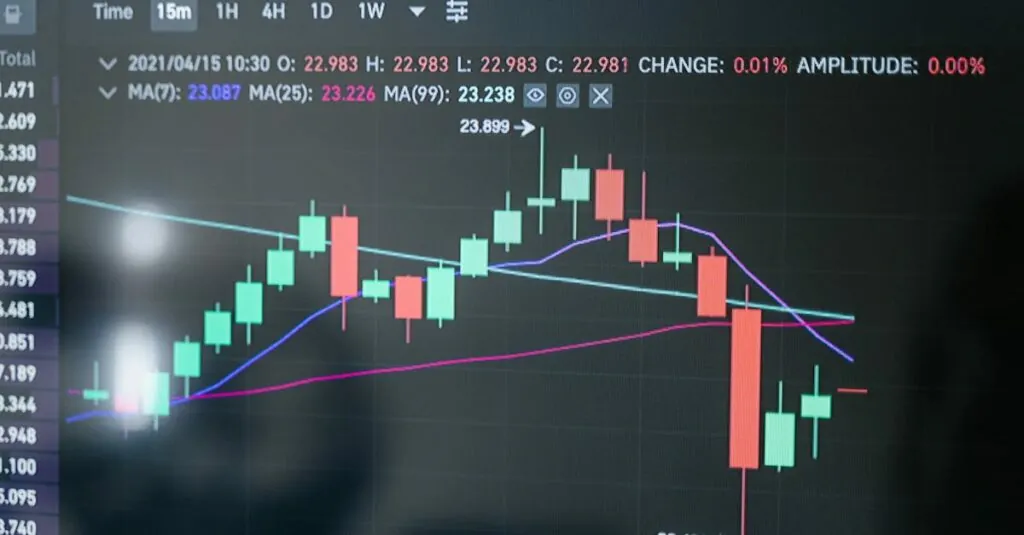Table of Contents
ToggleThe stock market crash isn’t just a historical footnote; it’s a rollercoaster ride that left investors screaming for mercy. In the context of APUSH—Advanced Placement United States History—understanding this phenomenon is crucial. It’s not just about numbers and graphs; it’s about the seismic shifts that shaped the American economy and society.
Understanding Stock Market Crash
The stock market crash represents a critical event in American economic history. This event reshaped many aspects of society and highlighted vulnerabilities within financial systems.
Definition in APUSH Context
In the APUSH context, a stock market crash refers to a sudden and dramatic decline in stock prices across a significant number of shares. This phenomenon serves as a reflection of investor panic and erosion of confidence in the economy. Often associated with broader economic downturns, such as the Great Depression, stock market crashes result in widespread financial distress and unemployment. Understanding this event helps students analyze its causes and effects within the larger narrative of American history.
Historical Significance
The historical significance of stock market crashes lies in their ability to transform economic policy and public perception. Events like the 1929 crash led to the implementation of regulations aimed at stabilizing the financial market, such as the Securities Act of 1933. These regulations sought to restore trust among investors and prevent future occurrences. Additionally, stock market crashes provoke shifts in societal attitudes toward wealth and governmental responsibility. By examining these repercussions, students gain insights into the changing landscape of American society and economy.
Key Events Leading to the Crash
Several events throughout the late 1920s contributed to the stock market crash. This period saw a mix of economic indicators and political factors that amplified investor fear and uncertainty.
Economic Indicators
Declining consumer confidence marked the late 1920s, as many Americans faced financial strain. Rising unemployment rates indicated a weakening economy. Additionally, overproduction in industries such as agriculture led to falling prices, creating surplus goods with little demand. Speculative investments ballooned; investors poured money into stocks without considering actual company values. By 1929, stock prices soared, detaching from the underlying economic fundamentals. Ultimately, these unsustainable practices laid the groundwork for a dramatic market collapse.
Political Factors
Legislative inaction exacerbated economic vulnerabilities during this time. Lack of federal regulation allowed rampant speculation and risky banking practices to proliferate. The government failed to address systemic weaknesses, leading to investor disillusionment. Tariffs, such as the Smoot-Hawley Tariff of 1930, negatively impacted international trade, stifling economic recovery. Distrust in political leaders grew as they struggled to respond effectively to the looming crisis. These political failings contributed significantly to the conditions that precipitated the crash, amplifying its effects on American society.
Impacts of the Stock Market Crash
The stock market crash significantly altered both society and the economy. Its repercussions were felt nationwide, influencing countless aspects of daily life.
Social Consequences
Increased unemployment rates drastically affected families and communities. Many individuals faced poverty, leading to a rise in homelessness and social unrest. The emotional strain on those who lost savings contributed to widespread anxiety and distrust in financial institutions. Changes occurred in societal attitudes toward wealth, shifting perspectives on prosperity. Citizens began to question government responsibilities, driving them to seek more accountability and support.
Economic Ramifications
Declining industrial production reflected the broader economic downturn caused by the crash. Businesses faced bankruptcy at alarming rates, resulting in massive layoffs and further economic instability. Financial institutions struggled, leading to a crisis of confidence in banks and investment firms. A dramatic decrease in consumer spending exacerbated the recession, causing lasting damage to the economy. Government intervention began to emerge as a necessary response, paving the way for future financial regulations like the New Deal policies.
Responses to the Stock Market Crash
The stock market crash prompted significant responses from various sectors, particularly the government, which sought to stabilize the economy and restore public confidence.
Government Interventions
Government interventions played a crucial role in addressing the aftermath of the stock market crash. Agencies like the Reconstruction Finance Corporation, established in 1932, provided loans to struggling banks and businesses, promoting economic recovery. Additionally, President Franklin D. Roosevelt’s New Deal introduced programs aimed at job creation and infrastructure improvement, which empowered millions of unemployed Americans. Emergency measures, such as the banking holiday in 1933, allowed for the closure of banks to prevent further bank runs and enforced a moratorium on foreclosures. These actions reflected a shift in governmental responsibility for economic stability, prioritizing the nation’s recovery from the financial crisis.
Changes in Regulation
Changes in regulation followed the stock market crash, fundamentally altering the financial landscape. The Securities Act of 1933 established transparency in securities trading, requiring companies to disclose financial information to protect investors. The creation of the Securities and Exchange Commission in 1934 provided oversight of the stock market, enforcing legal standards and recurring audits. Other significant regulations included the Glass-Steagall Act, which separated commercial and investment banking to reduce risks associated with speculation. These regulatory changes were designed to restore trust in the financial system, ensuring that similar events wouldn’t destabilize the economy in the future.
Understanding the stock market crash is crucial for grasping the complexities of American economic history. It serves as a stark reminder of the vulnerabilities within financial systems and the far-reaching impacts on society. The events surrounding the crash illustrate the delicate balance between market confidence and economic stability.
Through the lens of APUSH, students can appreciate how this pivotal moment reshaped government policies and societal attitudes toward wealth and responsibility. The lessons learned from the crash continue to resonate today, emphasizing the importance of regulatory frameworks in safeguarding against future economic turmoil.




